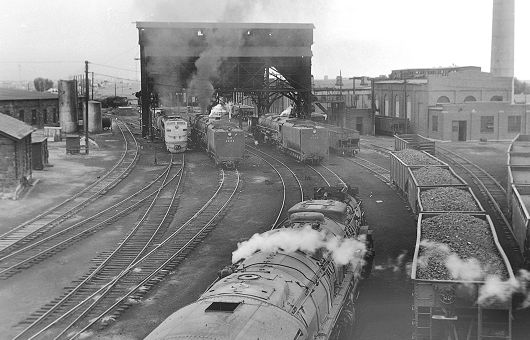|
|

This web site presents images of the Union Pacific Railroad's famous "Big Boy" 4-8-8-4 articulated locomotives, along with the well-known "Challenger" 4-6-6-4s. I took most of these photos on 35mm film during a family vacation trip from Illinois to Colorado and Wyoming in the summer of 1957, and my late brother David V. Leonard took others on his camera with a larger negative size. A few photos were taken later in museums or during a 2002 trip by Challenger 3985, the then-operating survivor of that class. In 1957 we encountered the 4-8-8-4s operating out of the Union Pacific terminal at Laramie, Wyoming, while the 4-6-6-4s frequented the main line between Cheyenne and Omaha. 
The Laramie terminal was a hotbed of activity, servicing the "Big Boys" plus other power including an American Locomotive Company delivered the "Big Boys" in two groups, Nos. 4000-4019 in 1941 and Nos. 4020-4024 in 1944. All locomotives had 68-inch drivers and cylinder dimensions of 23¾x32 inches, and sustained 300 pounds of boiler pressure per square inch. With these specifications they exerted 135,375 pounds of tractive force. The first group had a locomotive weight of 345 tons, a grate area of 135 square feet, and an evaporative heating surface of 5889 square feet. The second group were slightly heavier, with a larger grate area but reduced heating surface. Eight examples of this type survive today, with No. 4014 having been rebuilt by the Union Pacific steam shop in 2019 and returned to operation. For more information, visit the Union Pacific Steam Club site and Wes Barris' Union Pacific Big Boys page. The Challengers, also entirely ALCo-built, came in two types but all had 69-inch drivers and developed 97,300 pounds of tractive force. The earlier group, numbered 3800-3839 (originally 3900-3939), were built in 1936 and 1937 as class CSA. They had 22x32-inch cylinders, a boiler pressure of 255 pounds per square inch, and a locomotive weight of 566,000 to 592,000 pounds. The later Challengers, of class "4664," were delivered in three groups. Nos. 3950-3969 came in 1942, Nos. 3975-3999 in 1943, and Nos. 3930-3949 in 1944. They carried 280 pounds of boiler pressure and had 21x32-inch cylinders, and their locomotive weights ranged from 627,000 to 634,500 pounds. Mary-Nise Faria, a student from Goiania, Brazil, has created a "diaporama" (PowerPoint slides), "Challengers and 'Big Boys,'" based on the photos on this web site. Her presentation offers text in Portuguese, French, and English. To view an HTML English version (without Ms. Faria's PowerPoint visual effects), click >here<. Some of the Challengers were used in passenger service, for which they sported a special gray paint scheme. Some members of both Challenger classes were converted to burn oil, during which time they were renumbered into the 3700 series. No. 3977 is displayed today in North Platte, Nebraska. No. 3985 was restored to operation by Union Pacific in 1981 and converted to burn oil in 1990; it operated in the Union Pacific steam program for many years. (It is pictured here in service in 1957 as well.) Click on the selections below to view the full-size images. You can also page through the collection sequentially. A few shots of Northerns (styled by UP as "FEF" for 4-8-4) are included to fill out the page. For more commentary on our 1957 trip during which most of these photos were taken, visit the Union Pacific page in Richard Leonard's Steam Locomotive Archive and our Union Pacific Gas Turbines page. Dr. Richard Leonard  |
|


















































